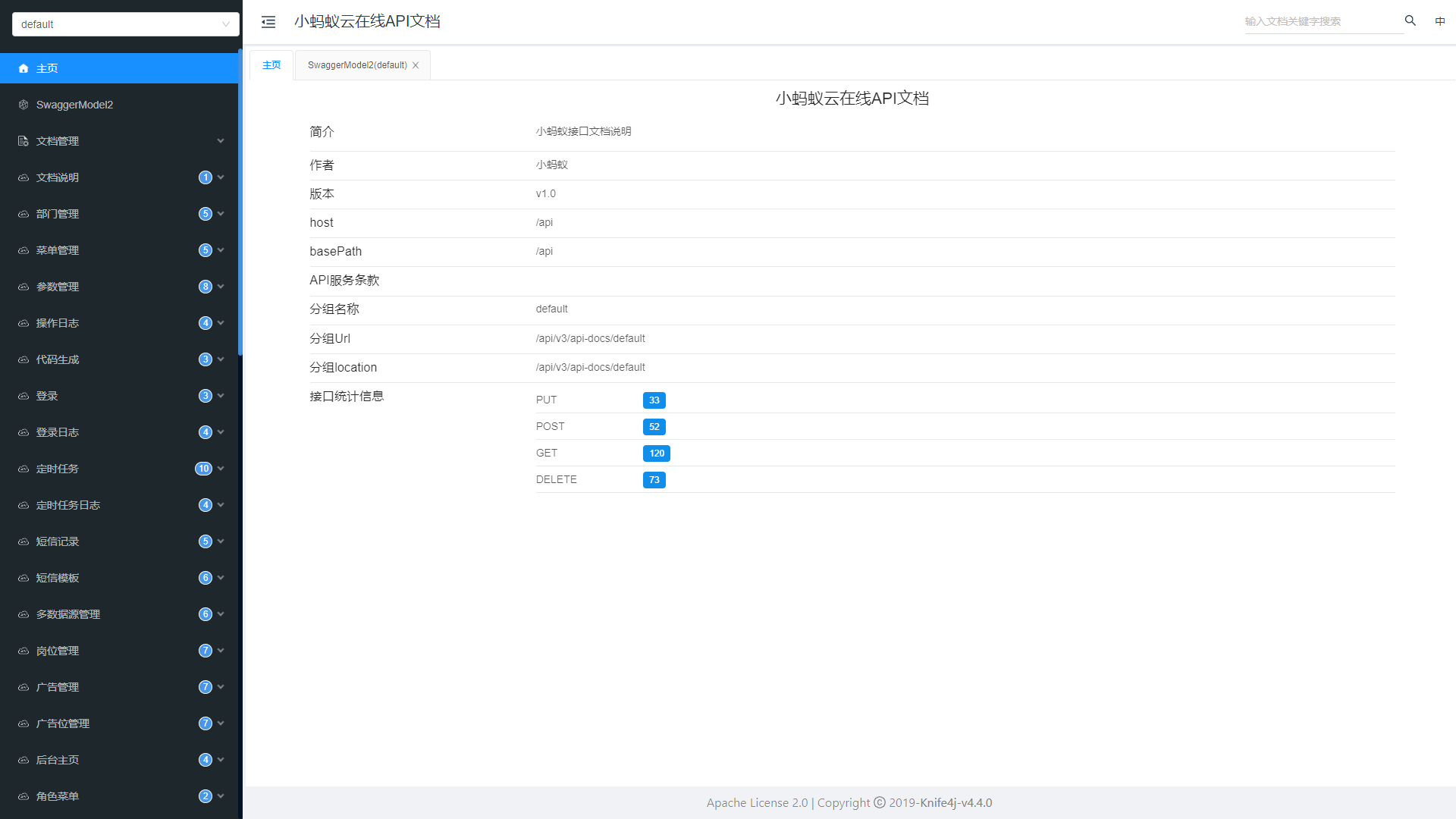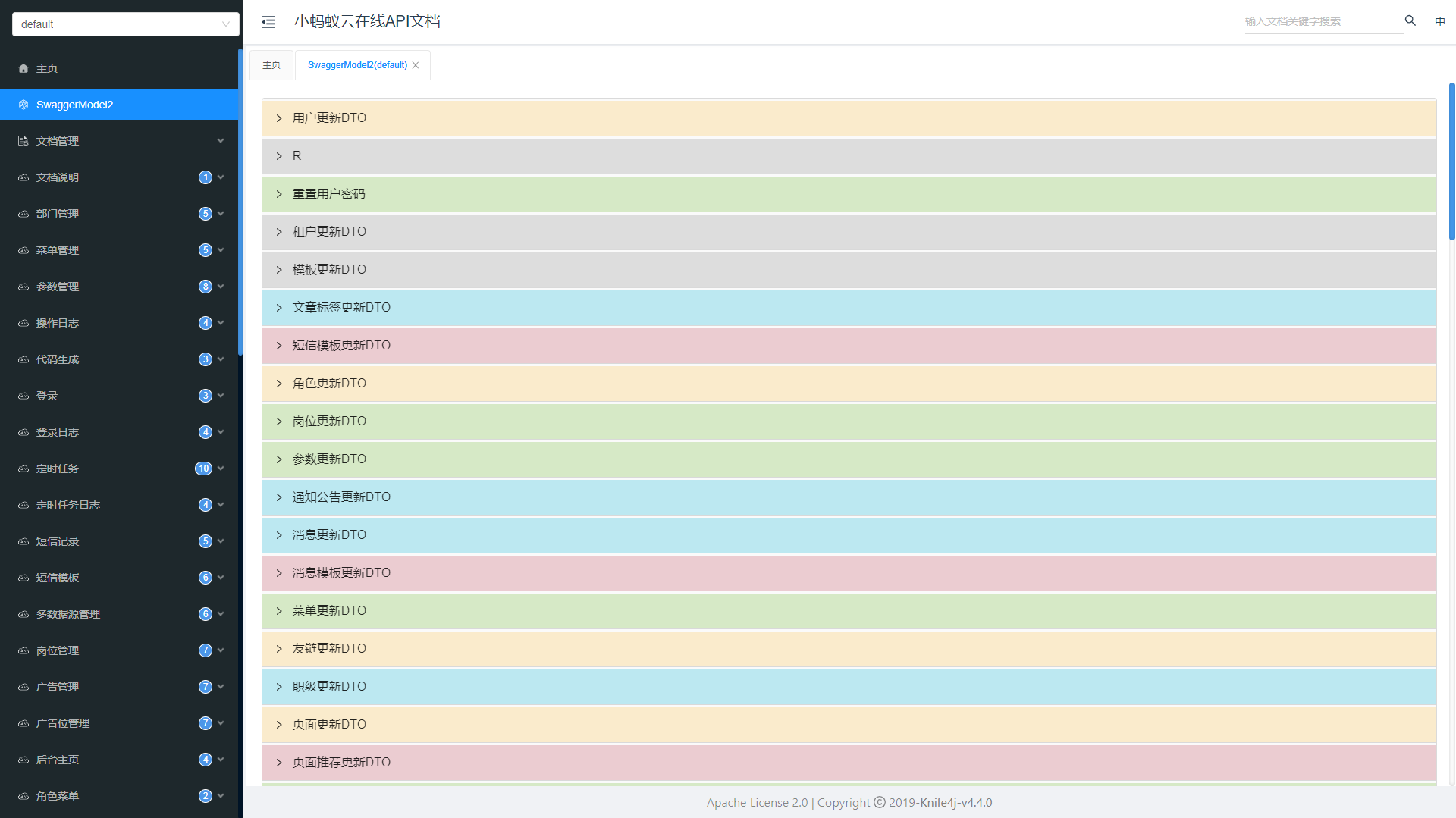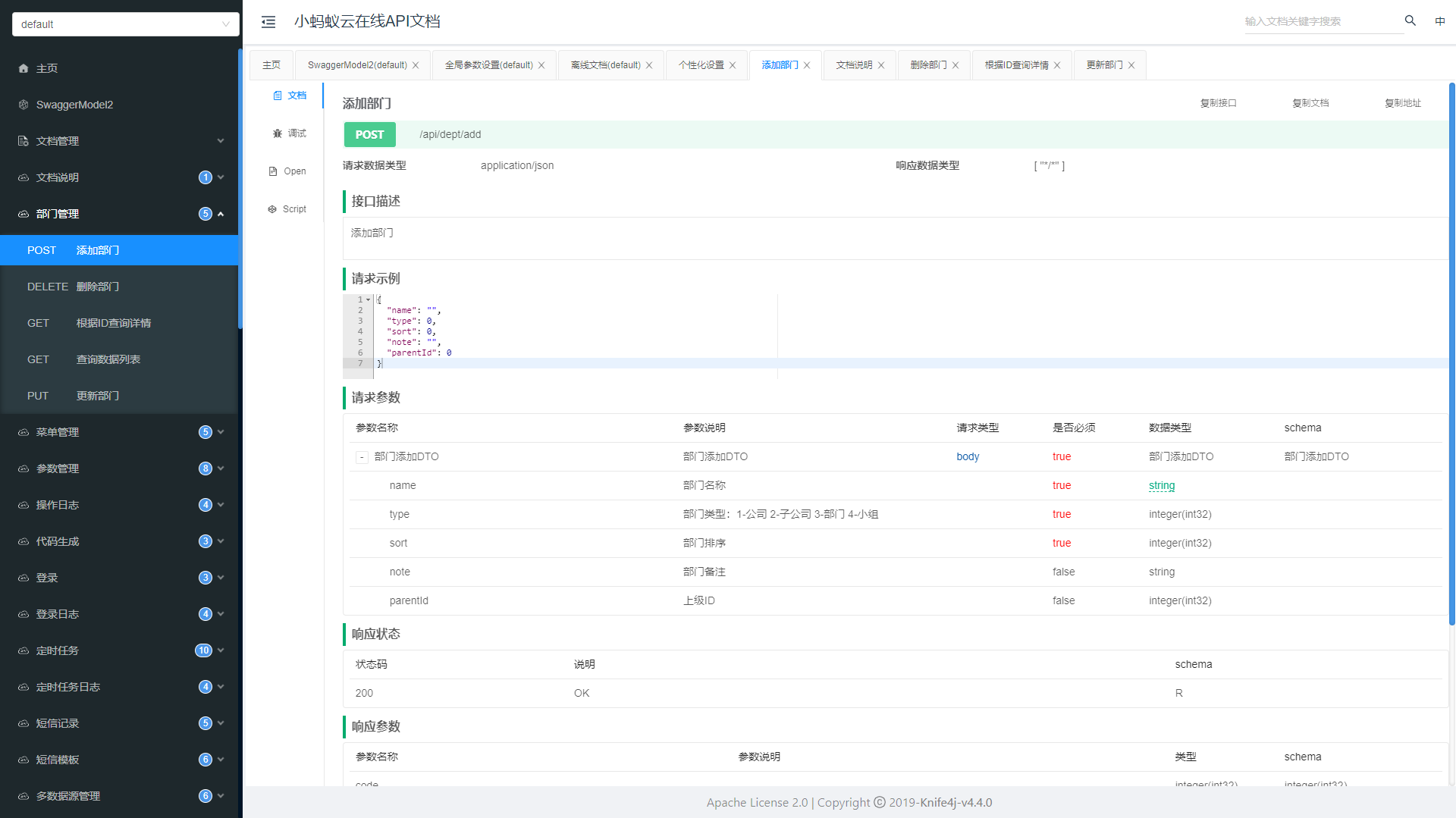Become a sponsor

Knife4j 是 Swagger 的增强版,专为 Java 开发者设计。它提供了以下核心功能:
UI 界面:更美观、更易用的文档界面。Markdown、HTML、Word 等格式的文档。API 接口。API。项目中使用 Knife4j 生成在线 API 文档,在 pom.xml 中添加 Knife4j 的依赖:
<!-- 依赖声明 -->
<dependencies>
<!-- knife4j+OpenAI3+SpringDoc+接口文档 -->
<dependency>
<groupId>com.github.xiaoymin</groupId>
<artifactId>knife4j-openapi3-jakarta-spring-boot-starter</artifactId>
</dependency>
</dependencies>Knife4j 是基于 Swagger 的增强工具,因此会自动引入 Swagger 的相关依赖。
Knife4 对应的 YML 配置文件 application-knife4j.yml 内容如下:
# knife4j的增强配置
knife4j:
# 开启knife4j,无需添加@EnableKnife4j注解
enable: true
# 生产环境建议设置为 true,禁用文档
production: false
# # 确保以下路径加上了API前缀
# doc-api:
# api-prefix: /api/
openapi:
title: 小蚂蚁云在线API文档
description: 小蚂蚁接口文档说明
email: xiaomayicloud@163.com
version: v1.0
# 文档定义配置
scheme: Bearer
# 文档访问头
header: Authorization
# 联系人
contact: 小蚂蚁
# 网址
url: https://www.xiaomayicloud.com
license: Apache 2.0
license-url: https://www.xiaomayicloud.com
terms-of-service-url: https://www.xiaomayicloud.com
# 是否启用登录认证
basic:
# 开启Swagger的Basic认证功能,默认是false
enable: false
# Basic认证用户名
username: admin
# Basic认证密码
password: 123456
# 前端UI的个性化配置属性
setting:
# 显示语言中文
language: zh_cn
# 开启版本
enable-version: true
# 是否显示界面中SwaggerModel功能
enable-swagger-models: true
# 重命名SwaggerModel名称,默认
swagger-model-name: SwaggerModel2
# 是否显示界面中"文档管理"功能
enable-document-manage: true
documents:
- name: 文档说明
locations: classpath:markdown/*
group: default温馨提示
上述配置文件项目中已包含,此处主要用于描述集成使用案例,便于企业和开发者能更好的理解。
项目中在线文档是专门的模块 xiaomayi-springdoc ,配置类,通过配置类 Knife4jConfig 定义 OpenAPI 的基本信息(如标题、描述、版本等)。
package com.xiaomayi.springdoc.config;
import io.swagger.v3.oas.models.ExternalDocumentation;
import io.swagger.v3.oas.models.OpenAPI;
import io.swagger.v3.oas.models.info.Contact;
import io.swagger.v3.oas.models.info.Info;
import io.swagger.v3.oas.models.info.License;
import io.swagger.v3.oas.models.servers.Server;
import org.springframework.context.annotation.Bean;
import org.springframework.context.annotation.Configuration;
import java.util.List;
/**
* <p>
* 在线文档配置类
* </p>
*
* @author 小蚂蚁云团队
* @since 2024-05-21
*/
@Configuration
public class Knife4jConfig {
/**
* SpringDoc 标题、描述、版本等信息配置
*
* @return openApi 配置信息
*/
@Bean
public OpenAPI springDocOpenAPI() {
return new OpenAPI()
// 设置文档API前缀
.info(new Info()
// 接口文档标题
.title(Knife4jProperties.getTitle())
// 接口文档简介
.description(Knife4jProperties.getDescription())
// 接口文档版本
.version(Knife4jProperties.getVersion())
.license(new License()
.name(Knife4jProperties.getTitle())
.url(Knife4jProperties.getUrl()))
// 开发者联系方式
.contact(new Contact()
.name(Knife4jProperties.getContact())
.email(Knife4jProperties.getEmail())))
// 设置服务器URL前缀
.servers(List.of(new Server().url("/api")))
.externalDocs(new ExternalDocumentation()
.description(Knife4jProperties.getDescription())
.url(Knife4jProperties.getUrl()));
}
}在控制器和方法上使用 OpenAPI 注解(如 @Tag、@Operation 等)来描述 API,实例如下:
package com.xiaomayi.admin.controller;
import cn.hutool.http.HttpStatus;
import com.xiaomayi.core.config.AppConfig;
import com.xiaomayi.core.exception.BizException;
import com.xiaomayi.core.utils.R;
import com.xiaomayi.excel.utils.ExcelUtil;
import com.xiaomayi.logger.annotation.RequestLog;
import com.xiaomayi.logger.enums.RequestType;
import com.xiaomayi.system.dto.level.LevelAddDTO;
import com.xiaomayi.system.dto.level.LevelListDTO;
import com.xiaomayi.system.dto.level.LevelPageDTO;
import com.xiaomayi.system.dto.level.LevelUpdateDTO;
import com.xiaomayi.system.service.LevelService;
import com.xiaomayi.system.vo.level.LevelExcelVO;
import io.swagger.v3.oas.annotations.Operation;
import io.swagger.v3.oas.annotations.tags.Tag;
import lombok.AllArgsConstructor;
import org.springframework.security.access.prepost.PreAuthorize;
import org.springframework.validation.annotation.Validated;
import org.springframework.web.bind.annotation.*;
import org.springframework.web.multipart.MultipartFile;
import java.util.List;
/**
* <p>
* 职级 前端控制器
* </p>
*
* @author 小蚂蚁云团队
* @since 2024-03-23
*/
@RestController
@RequestMapping("/level")
@Tag(name = "职级管理", description = "职级管理")
@AllArgsConstructor
public class LevelController {
private final LevelService levelService;
/**
* 查询分页列表
*
* @param levelPageDTO 查询条件
* @return 返回结果
*/
@Operation(summary = "查询分页列表", description = "查询分页列表")
@PreAuthorize("@pms.hasAuthority('sys:level:page')")
@GetMapping("/page")
public R page(LevelPageDTO levelPageDTO) {
return R.ok(levelService.page(levelPageDTO));
}
/**
* 查询数据列表
*
* @param levelListDTO 查询条件
* @return 返回结果
*/
@Operation(summary = "查询数据列表", description = "查询数据列表")
@PreAuthorize("@pms.hasAuthority('sys:level:list')")
@GetMapping("/list")
public R getList(LevelListDTO levelListDTO) {
return R.ok(levelService.getList(levelListDTO));
}
/**
* 根据ID查询详情
*
* @param id 职级ID
* @return 返回结果
*/
@Operation(summary = "根据ID查询详情", description = "根据ID查询详情")
@PreAuthorize("@pms.hasAuthority('sys:level:detail')")
@GetMapping("/detail/{id}")
public R getDetail(@PathVariable("id") Integer id) {
return R.ok(levelService.getDetail(id));
}
/**
* 添加职级
*
* @param levelAddDTO 参数
* @return 返回结果
*/
@Operation(summary = "添加职级", description = "添加职级")
@RequestLog(title = "添加职级", type = RequestType.INSERT)
@PreAuthorize("@pms.hasAuthority('sys:level:add')")
@PostMapping("/add")
public R add(@RequestBody @Validated LevelAddDTO levelAddDTO) {
return levelService.add(levelAddDTO);
}
/**
* 更新职级
*
* @param levelUpdateDTO 参数
* @return 返回结果
*/
@Operation(summary = "更新职级", description = "更新职级")
@RequestLog(title = "更新职级", type = RequestType.UPDATE)
@PreAuthorize("@pms.hasAuthority('sys:level:update')")
@PutMapping("/update")
public R update(@RequestBody @Validated LevelUpdateDTO levelUpdateDTO) {
return levelService.update(levelUpdateDTO);
}
/**
* 删除职级
*
* @param id 记录ID
* @return 返回结果
*/
@Operation(summary = "删除职级", description = "删除职级")
@RequestLog(title = "删除职级", type = RequestType.DELETE)
@PreAuthorize("@pms.hasAuthority('sys:level:delete')")
@DeleteMapping("/delete/{id}")
public R delete(@PathVariable Integer id) {
return levelService.delete(id);
}
/**
* 批量删除职级
*
* @param idList 记录ID
* @return 返回结果
*/
@Operation(summary = "批量删除职级", description = "批量删除职级")
@RequestLog(title = "批量删除职级", type = RequestType.BATCH_DELETE)
@PreAuthorize("@pms.hasAuthority('sys:level:batchDelete')")
@DeleteMapping("/batchDelete")
public R batchDelete(@RequestBody @Validated List<Integer> idList) {
return levelService.batchDelete(idList);
}
/**
* 导出职级
*
* @return 返回结果
*/
@RequestLog(title = "导出职级", type = RequestType.EXPORT)
@Operation(summary = "导出职级", description = "导出职级")
@PreAuthorize("@pms.hasAuthority('sys:level:export')")
@GetMapping("/export")
public R exportLevel(LevelListDTO levelListDTO) {
return levelService.exportLevel(levelListDTO);
}
/**
* 导入职级
*
* @param file 文件
* @return 返回结果
* @throws Exception 异常处理
*/
@RequestLog(title = "导入职级", type = RequestType.IMPORT)
@Operation(summary = "导入职级", description = "导入职级")
@PreAuthorize("@pms.hasAuthority('sys:level:import')")
@PostMapping("/import")
public R importLevel(MultipartFile file) throws Exception {
// 实例化导出对象工具
ExcelUtil<LevelExcelVO> util = new ExcelUtil<>(LevelExcelVO.class);
// 获取导入数据源
List<LevelExcelVO> list = util.importExcel(file.getInputStream());
// 导入数据源
return levelService.importLevel(list);
}
}启动项目后,访问以下 URL 查看 Knife4j 文档:
Knife4j UI:http://localhost:8081/api/doc.html
Swagger UI:http://localhost:8081/api/swagger-ui/index.html
OpenAPI JSON:http://localhost:8081/api/v3/api-docs


注意事项
knife4j.production=true 禁用文档,避免暴露。Docket 配置中设置多个分组。Knife4j 版本:确保使用最新版本的 Knife4j,以获得更好的功能和兼容性。可以在项目中轻松集成 Knife4j,并生成功能强大、界面友好的 API 文档。Knife4j 不仅兼容 Swagger,还提供了更多实用功能(如离线文档导出、接口搜索、动态参数调试等),非常适合企业级项目的 API 文档管理。